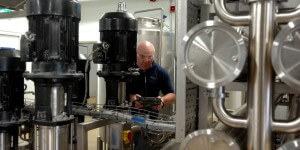Vibration Analysis – Reading the Vibration Signature
Vibration analysis as part of a condition based monitoring program can help to detect machine failure before it becomes an issue and impacts any unplanned downtime. With correct use it can allow for the repair of a machine before the occurrence of an expensive unplanned failure.
While there are simple ‘go, no-go’ instruments which will give a measurement, vibration analysers use top of the range equipment to measure the movement of a machine. It is upon analysis that the abnormality of the movement is assessed and the root of preventative maintenance can be detected. All rotating machines produce movement and vibration due to the shaft turning and causing frictional and rotational forces. It is this vibration signature that is read in vibration analysis.
There is a difference between measuring ‘shock pulses’ and vibration however; ‘shock pulse’ measurements play an important part of trending wear and lubrication film monitoring in rolling element bearings, whereas RMS when measured in the conventional three planes provides an overall picture of many more operating conditions to the machine.

Shock pulse operates at somewhere around 35-40 KHz. This means that defects in the rolling elements and cage of the bearing can be detected before they would show up using vibration (up to 5-10 KHz). Vibration is actually a repetitive and cyclical movement. All equipment vibrates but movement can become more exaggerated as bearings and components age. A trained VA engineer is able to assess the difference between normal movement and vibrational movement from a machine.

A fault can be detected via an increase in frequency and amplitude. For most accurate results it’s important to compare results over time to detect changes in signatures and to detect the early signs of wear. In order to assess the condition of a rotating machine it is important to be aware of such conditions as wear, resonance, movement, looseness etc. in order to make an informed decision as to which is the best cause of action to take in order minimise the risk to safety, production and to avoid expensive repair costs.
For more information on Vibration Analysis and Condition Based Motoring contact CPM Engineering on 0161 865 6161 or email info@cpm-uk.com.
